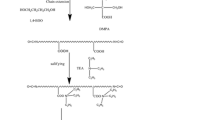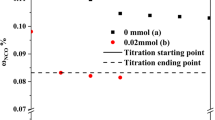Abstract
Propylene carbonate diols (PCD) were synthesized from propylene carbonate and ethylenediamine (EDA), iso-phorone diamine (IPDA) and diethylenetriamine (DETA), respectively. The obtained PCDs were used as extenders to prepare the waterborne polyurethane (WPU). The properties of PCD based WPUs were compared to the that of WPU used butane-1,4-diol (BDO) as extender. The structures of PCDs were characterized by Fourier transform infrared (FTIR) and nuclear magnetic resonance (NMR). The yields, melting points and viscosity of PCDs were tested. The mechanical properties, water absorption, water contact angle, adhesion, pencil hardness, thermal gravimetric analysis (TGA), differential scanning calorimeter (DSC) and dynamic mechanical analysis (DMA) of WPU films were also characterized. The results showed that PCDs with urethane bond in the structure were successfully synthesized and the yields were approximately 99% after 3 h of reaction. Compared to the WPU used BDO as extender, WPU films derived from PCDs exhibited superior tensile strength, outstanding adhesion and pencil hardness, lower water contact angle and water absorption, and higher initial thermal decomposition temperature.










Similar content being viewed by others
References
Cao H, Liu S, Wang X (2022) Environmentally benign metal catalyst for the ring-opening copolymerization of epoxide and CO2: state-of-the-art, opportunities, and challenges. Green Chem Eng 3:111–124
Li Y, Dai M, Chen X, Yang YP, Yang Mo WJ, Huang PC (2022) Synergetic effect and mechanism between propylene carbonate and polymer rich in ester and ether groups for CO2 physical absorption. J Clean Prod 336:130389
North M, Pasquale R, Young C (2010) Synthesis of cyclic carbonates from epoxides and CO2. Green Chem 12:1514–1539
Musa SG, Zulkifli MA, Merican OA (2021) Study on Selected Metal-Organic Framework-Based Catalysts for Cycloaddition Reaction of CO2 with Epoxides: A Highly Economic Solution for Carbon Capture and Utilization. Polymers 13:3905
Aouissi A, Aldhayan D, Naaser AY, Abduh AA, Kahtani, (2020) Propylene carbonate synthesis from propylene oxide and CO2 over Ga-Silicate-1 catalyst. Green Process Synthesis 9:440–450
Kumar N, Srivastava VC (2020) Dimethyl carbonate synthesis via transesterification of propylene carbonate using efficient reduced graphene oxide supported ZnO nanocatalyst. Energy Fuels 34:7455–7464
Wang J, Zhang H, Miao Y, Qiao L, Wang X, Wang F (2016) Waterborne polyurethanes from CO2 based polyols with comprehensive hydrolysis/oxidation resistance. Green Chem 18:524–530
Xian W, Yuan J, Xie Z, Ou W, Liu X, Liu B (2021) Synthesis and properties of CO2 copolymer-based waterborne polyurethane with high solid content. J Polym Res 28:254
Lu XL, Du FG, Ge XC, Xiao M, Meng YZ (2006) Biodegradability and thermal stability of poly (propylene carbonate)/starch composites. J Biomed Mater Res 77:653–658
Kim G, Ree M, Kim H, Kim IJ, Kim JR, Lee JI (2008) Biological affinity and biodegradability of poly (propylene carbonate) prepared from copolymerization of carbon dioxide with propylene oxide. Macromol Res 16:473–480
Langanke J, Wolf A, Hofmann J, Böhm K, Subhani MA, Müller TE, Leitner W, Gürtler C (2014) Carbon dioxide (CO2) as sustainable feedstock for polyurethane production. Green Chem 16:1865–1870
Liu Z, Huang J, Chen S, Huang Y, Ding F, Guo W, Lei D, Yang L, Qing F, You Z (2020) CO2-based poly (propylene carbonate) with various carbonate linkage content for reactive hot-melt polyurethane adhesives. Int J Adhes Adhes 96:102456
Dai S, Li P, Li X, Ning C, Kong L, Fang L, Liu Y, Liu L, Ao Y (2021) Waterborne polyurethanes from self-catalytic tartaric acid-based polyols for environmentally-friendly sizing agents. Compos Commun 27:100849
Xian W, Song L, Liu B, Ding H, Le M (2017) Rheological and mechanical properties of thermoplastic polyurethane elastomer derived from co2 copolymer diol. J Appl Polym Sci 135:45974
Chattopadhyay DK, Raju KVSN (2007) Structural engineering of polyurethane coatings for high performance applications. Prog Polym Sci 32:352–418
Ma L, Song L, Li F, Wang H, Liu B (2017) Preparation and properties of poly (propylene carbonate)-based waterborne polyurethane-acrylate composite emulsion. Colloid Polym Sci 295:2299–2307
Jang JY, Jhon YK, Cheong IW, Kim JH (2002) Effect of process variables on molecular weight and mechanical properties of water-based polyurethane dispersion. Colloids Surf 196:135–143
Chen Y, Liu Z, Han S, Han J, Jiang D (2016) Poly(propylene carbonate) polyurethane self-polishing coating for marine antifouling application. J Appl Polym Sci 133:43367
Wang J, Zhang H, Miao Y, Qiao L, Wang X, Wang F (2016) UV-curable waterborne polyurethane from CO2-polyol with high hydrolysis resistance. Polymer 100:219–226
Ma L, Song L, Wang H, Fan L, Liu B (2018) Synthesis and characterization of poly (propylene carbonate) glycol-based waterborne polyurethane with a high solid content. Prog Org Coat 122:38–44
Webster DC (2003) Cyclic carbonate functional polymers and their applications. Prog Org Coat 47:77–86
Mamat S, Abdullah LC, Aung MM, Rashid SA, Salleh MZ, Saalah S, Jusoh ER, Rayung M (2022) Synthesis and Characterization UV-Curable Waterborne Polyurethane Acrylate/Al2O3 Nanocomposite Coatings Derived from Jatropha Oil Polyol. Biointerface Res Appl Chem 13:193
Kwon YR, Kim HC, Moon SK, Kim JS, Chang Y-W, Kim DH (2022) Facile preparation and characterization of low-gloss waterborne polyurethane coatings using amine-based chain extenders. Polym Int. https://doi.org/10.1002/pi.6446
Liu B, Chen L, Zhang M, Yu A (2002) Degradation and Stabilization of Poly (propylene carbonate). Macromolecular 23:881–884
Pan H, Hao Y, Hao Y, Lang X, Zhang Y, Wang Z, Zhang H, Dong L (2017) Improved mechanical properties, barrier properties and degradation behavior of poly (butylenes adipate-co-terephthalate) /poly (propylene carbonate) films. Korean J Chem Eng 34:1294–1304
Gholami M, Shakeri A, Zolghadr M, Yamini G (2021) Non-Isocyanate polyurethane from the extracted tannin of sumac leaves: Synthesis, characterization, and optimization of the reaction parameters. Ind Crops Prod 161:113195
Cakić SM, Valcic MD, Ristić IS, Radusin T, Cvetinov MJ, Budinski-Simendić J (2019) Waterborne polyurethane-silica nanocomposite adhesives based on castor oil-recycled polyols: Effects of (3aminopropyl) triethoxysilane (APTES) content on properties. Int J Adhes Adhes 90:22–31
Li R, Shan Z (2022) Annealing treatment on waterborne polyurethane film-forming and structural features induced heat conduction performance in conductive adhesive. Int J Adhes Adhes 117:103173
Author information
Authors and Affiliations
Corresponding authors
Ethics declarations
Conflict of interest statement
We declare that we have no financial and personal relationships with other people or organizations that can inappropriately influence our work, there is no professional or other personal interest of any nature or kind in any product, service and/or company that could be construed as influencing the position presented in, or the review of, the manuscript entitled “Synthesis of novel propylene carbonate diol(PCD)and application in CO2-based polyols waterborne polyurethane”.
Additional information
Publisher's Note
Springer Nature remains neutral with regard to jurisdictional claims in published maps and institutional affiliations.
Rights and permissions
Springer Nature or its licensor holds exclusive rights to this article under a publishing agreement with the author(s) or other rightsholder(s); author self-archiving of the accepted manuscript version of this article is solely governed by the terms of such publishing agreement and applicable law.
About this article
Cite this article
He, Z., Xian, W., Ding, Z. et al. Synthesis of novel propylene carbonate diol(PCD)and application in CO2-based polyols waterborne polyurethane. J Polym Res 29, 445 (2022). https://doi.org/10.1007/s10965-022-03288-9
Received:
Accepted:
Published:
DOI: https://doi.org/10.1007/s10965-022-03288-9




